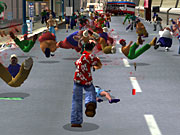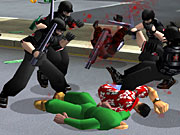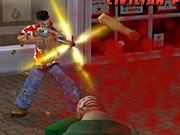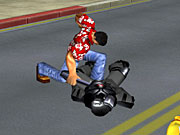State of Emergency is an arcade-style action game that puts you in the shoes of a rebel fighting against an oppressive corporation that has become a sort of de facto government. While State of Emergency's arcadelike objectives and somewhat simplistic fighting system can make it feel a little shallow, the game's technical strengths, satisfying displays of comically overblown violence, and budget price make it worth a look, provided you own a good dual analog gamepad.

State of Emergency was originally released over a year ago on the PlayStation 2, and a handful of changes have been made for the PC version, which mirrors the more-recent Xbox version's set of features. For starters, the game's graphics are sharper, and, provided your system meets the game's recommended system specifications, the game will usually run at a smooth 60 frames per second, even though you'll constantly see tons of people running in every direction in the game's riotlike environments. Secondly, a handful of four-player multiplayer modes have been added, though the lack of any player-matching in the game makes finding a game nearly impossible. And finally, some new power-ups provide you with temporary bursts of unlimited ammo, extra fight power, resistance to bullets, or even a posse of AI-controlled gang members that help you take down your enemies. While no one improvement causes the PC version to leave the PS2 game in the dust, they add up pretty well.
State of Emergency, like just about every game that has tried to bring the beat-'em-up formula of the arcade classic Final Fight into a 3D world, has its share of problems. For starters, the camera requires constant baby-sitting, forcing you to frequently hit the aim button to swing it around behind your character or use the touchy manual camera controls to adjust your perspective. Even still, the camera gets hung up in tight corridors, and you'll often find yourself walking around corners blindly, only to find a large enemy force on the other side that opens fire before you even have time to reposition the camera to see them. The game also controls terribly with a mouse and keyboard and all but requires a dual analog PC gamepad--or better yet, a PlayStation controller hooked up via a USB adapter--to be played as was originally intended.
Additionally, the basic gameplay is extremely simple, almost to the point of feeling stripped down. You have a punch and a kick at your disposal, and mashing on the buttons will execute combos. Hitting both buttons together allows you to grab opponents for throws and other holds. But the game is perhaps at its best when your character is armed. There's a wide variety of weapons in State of Emergency, starting out with simple batons and baseball bats. The game also features a nice selection of firearms, including a pistol, an Uzi, an AK-47, an M16, a shotgun, a minigun, a flamethrower, a grenade launcher, and a rocket launcher. You'll also find some blades, namely a hatchet and a sword. Finally, many objects found around the environment--park benches, for example--can be picked up and thrown. You'll need this large arsenal to keep the corporation security forces and gangs at bay. As you proceed, the enemies will rush you with larger numbers and better armaments.

The game's main mode is called "chaos." Chaos' main selection, confusingly called "kaos," plays similarly to Sega's Crazy Taxi. You are given a limited amount of time to earn points, but you can earn more time by picking up time power-ups, which are usually earned by killing enemies. The idea is to strike a balance between rioting to earn points and fighting to replenish your health and time. As you play, various bonuses switch on and off. For instance, on occasion, you'll earn 10 times as many points for destroying objects as you normally would, or there will be a five-times multiplier on window breaking. Also switching on and off is the civilian kill penalty, which costs you points if you mow down bystanders when it's enabled. When the penalty is off, you can freely unload your weapons into the crowd, though it should be noted that you never actually earn points or bonuses by killing civilians. The point of chaos mode is to earn points. Once you reach a certain score plateau, the next level is unlocked. In addition to the push and pull of the kaos selection, there are also variants with fixed time limits. Completing these unlocks the "last clone standing" selection, which puts you in the level with 200 defenseless drones and asks you to kill them all in the fastest time possible.
State of Emergency's storyline seems like an afterthought that attempts to provide a reason for the rioting--so much so that the game's main mode doesn't contain any story elements whatsoever. In the not-so-distant future, the government is overtaken by a large corporation that is, of course, evil and extremely oppressive. As things reach Big Brother-like levels, the populace, full of fear, begins to riot. You are a member of Freedom, an organization bent on overthrowing the evil government and getting things back to normal. The story only appears in the game's mission-based revolution mode. In this mode, the scoring and time limits of the chaos mode are replaced by various task-based objectives. Here, you'll advance Freedom's cause by blowing up buildings, killing corporation executives, and guarding people and places that are friendly to the resistance. Weapons are a lot harder to come by in this mode, as they're usually only given out for specific missions, rather than found on the ground all over the place.

There are a ton of missions in the game, and each one must be completed to move forward. Some of the missions are well designed and fun, but most of them are either mindlessly simple tasks or frustrating trial-and-error endeavors that force you to find the path of least resistance through a given map. In the end, the mission mode seems more like busywork than anything else, and it definitely deserves its secondary status. Though, advancing in this mode does increase the selection of playable characters, which starts at two and grows to a total of five.
The game's multiplayer option lets you play with two to four players in a variety of cooperative and competitive games. Deathmatch is your basic player-vs.-player mode, and there are also variants on the single-player game's last clone standing and kaos games. Survivor mode is a last man standing sort of game that ends when only one player is left alive. The multiplayer modes are a good addition, though they aren't quite as fleshed out as they could have been. And again, the lack of in-game player-matching makes looking for a quick match online impractical to say the least.
State of Emergency was a pretty amazing graphical achievement when it came to the PlayStation 2 last year--you just don't normally see that many characters running around onscreen at once. The Xbox and PC versions clean things up a bit and improve the frame rate, though the game's crisper look betrays its rather simplistic geometry. But considering how smoothly the game runs and how many people are packed onscreen at once, the game is still pretty impressive. Without the ability to put this many people onscreen, State of Emergency would lose a lot of its impact--there's nothing quite as satisfying as launching a rocket or grenade into a huge crowd of people and watching the blood and limbs fly like something out of some demented cartoon.

The sound effects throughout the game are good, and they effectively convey the feeling of a riot. You'll hear people shrieking as they run around like lunatics, and the weapon fire is done well. Unfortunately, there seems to be a bug in the game that causes some sound effects to simply cut off. The music consists of fairly generic-sounding techno and rock tracks.
State of Emergency isn't exactly the deepest game on the market, but with its timers and its high-score lists, the game is definitely shooting for shorter, arcadelike play sessions. While it might be a bit much to ask players to pay full price for a port of a year-old PS2 game, the PC version's new features and bargain-minded retail price make it a good deal for anyone looking for some mindless fun.